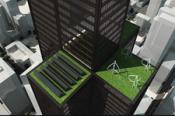 Plans announced Wednesday unveiled a new green renovation plan for the tallest building in the Western Hemisphere, The Sears Tower. The project will result in unparalleled energy savings and reduced CO2 emissions, cutting electricity use by up to 80 percent and incorporating its own wind power with the installation of compact turbines on the tower’s tiered roofs.
Plans announced Wednesday unveiled a new green renovation plan for the tallest building in the Western Hemisphere, The Sears Tower. The project will result in unparalleled energy savings and reduced CO2 emissions, cutting electricity use by up to 80 percent and incorporating its own wind power with the installation of compact turbines on the tower’s tiered roofs.
The energy savings will equal 68 million kilowatt hours or 150,000 barrels of oil every year. The sustainability plans also include installing solar panels on the tower’s 90th floor and planting 30,000 square feet of roof gardens.
“Sears Tower, an iconic structure that defines the city’s skyline, will undergo a groundbreaking transformation that creates economic growth with positive impact on our environment, leaving a lasting legacy for future generations,” said John Huston of American Landmark Properties, representing the partnership that owns Sears Tower.
“As the stewards of this icon, we take seriously our responsibility to make it relevant and successful, and the changes made and benefits realized through the bold sustainable initiatives at the tower will serve as an example.”
The building, first opened in 1973, already meets the Leadership in Energy and Environmental Design (LEED) criteria, but will undertake sustainability measures above and beyond those used by the US Green Building Council to rate a green building.
Modernization strategies, designed by Chicago-based Adrian Smith + Gordon Gill Architecture, include:
- Efficiency improvements to the building’s windows, replacing and glazing 16,000 single-pane windows
- New gas boilers that utilize fuel cell technologies, which provide electricity, heating and cooling at as much as 90 percent efficiency
- New high-efficiency chillers and upgrades to the distribution system
- Upgrades for 104 high speed elevators and 15 escalators to achieve 40 percent reduction in energy consumption
- Water savings that will be realized with conservation initiatives through upgrades to restroom fixtures, condensation recovery systems and water efficient landscaping




















